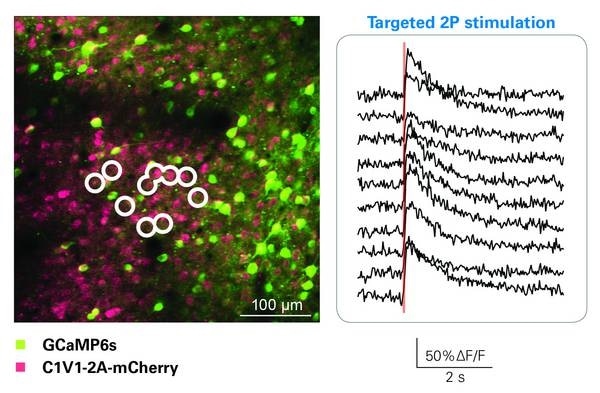http://www.news-medical.net/news/20161115/Bruker-launches-Ultima-NeuraLight-3D-imaging-platform-for-neuroscience-applications.aspx
New Ultima NeuraLight 3D Advances Research in Neural Connectivity and Networks
At the 46th Annual Meeting of the Society for Neuroscience, Bruker (NASDAQ: BRKR) today announced the release of the Ultima NeuraLight 3D™ simultaneous, all-optical stimulation and imaging platform for neuroscience applications.
The NeuraLight 3D module is the most advanced 3D holographic solution for multi-cell brain research to decode neural connectivity and neural networks. Bruker’s proprietary spatial light module (SLM) technology enables the mapping of neural networks on an unprecedented level with respect to stimulation frequency and spatial resolution on both in vivo and in vitro experimental models.

“Ultima NeuraLight 3D builds on over 15 years of experience of developing flexible, modular, and highest performance multiphoton microscopy for neuroscience research,” explained Xiaomei Li, Ph.D., Vice President and General Manager for Bruker’s Fluorescence Microscopy Business Unit.
“This history gives us an intimate understanding of the challenges facing today’s neuroscientists, and the unique ability to provide enabling technology for the next step in cutting-edge optogenetics research.”
The NeuraLight 3D module mates to one of the Ultima’s optical ports, and in coordination with new licensed technology, enables researchers to create a 3D laser hologram to simultaneously stimulate cells in three dimensions.
With a comprehensive software toolkit, NeuraLight 3D is able to generate and rapidly switch between 3D activation patterns, while imaging, recording electrical signals, and triggering behavioral and electrical stimuli, all at industry-leading switching rates of 300 to 500 hertz.
The number of targets that can be activated and observed is limited only by the peak power of the laser used for stimulation. The Ultima NeuraLight 3D module is available as an option for all new Ultima multiphoton systems, and as an upgrade to Ultima systems produced since 2006.
At the 46th Annual Meeting of the Society for Neuroscience, Bruker (NASDAQ: BRKR) today announced the release of the Ultima NeuraLight 3D™ simultaneous, all-optical stimulation and imaging platform for neuroscience applications.
The NeuraLight 3D module is the most advanced 3D holographic solution for multi-cell brain research to decode neural connectivity and neural networks. Bruker’s proprietary spatial light module (SLM) technology enables the mapping of neural networks on an unprecedented level with respect to stimulation frequency and spatial resolution on both in vivo and in vitro experimental models.

Optical stimulation of selected cells
containing GCaMP6s using NeuraLight 3D. Cell bodies were stimulated
simultaneously by creating a 3D hologram of points with the SLM and
spiral scanning all points over the cell body. Courtesy of Adam Packer,
Lloyd Russell, Henry Dalgleish, and Michael Hausser (University College
London).
This significant breakthrough in 3D optical stimulation, in
conjunction with multiphoton microscopy, was achieved in close
collaboration with leaders in neuroscience research at Stanford
University, Columbia University, and University College London.The Ultima SLM opens the door to previously impossible experiments for patterned all-optical interrogation of neuronal circuits,”
Professor Michael Hausser of University College London.
“Ultima NeuraLight 3D builds on over 15 years of experience of developing flexible, modular, and highest performance multiphoton microscopy for neuroscience research,” explained Xiaomei Li, Ph.D., Vice President and General Manager for Bruker’s Fluorescence Microscopy Business Unit.
“This history gives us an intimate understanding of the challenges facing today’s neuroscientists, and the unique ability to provide enabling technology for the next step in cutting-edge optogenetics research.”
About Ultima NeuraLight 3D
The Ultima NeuraLight 3D builds on the modular platform design of Bruker’s Ultima Multiphoton Microscopes to further augment its capabilities. The Ultima platform has a proven track record of facilitating cutting-edge research in neuroscience by pioneering advanced photoactivation and photostimulation of biological tissues. NeuraLight 3D is the next step in this platform of game-changing products.The NeuraLight 3D module mates to one of the Ultima’s optical ports, and in coordination with new licensed technology, enables researchers to create a 3D laser hologram to simultaneously stimulate cells in three dimensions.
With a comprehensive software toolkit, NeuraLight 3D is able to generate and rapidly switch between 3D activation patterns, while imaging, recording electrical signals, and triggering behavioral and electrical stimuli, all at industry-leading switching rates of 300 to 500 hertz.
The number of targets that can be activated and observed is limited only by the peak power of the laser used for stimulation. The Ultima NeuraLight 3D module is available as an option for all new Ultima multiphoton systems, and as an upgrade to Ultima systems produced since 2006.
Source:
No comments:
Post a Comment